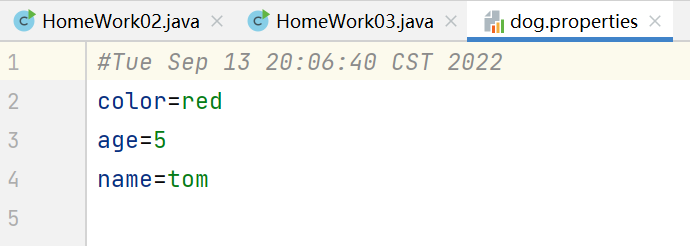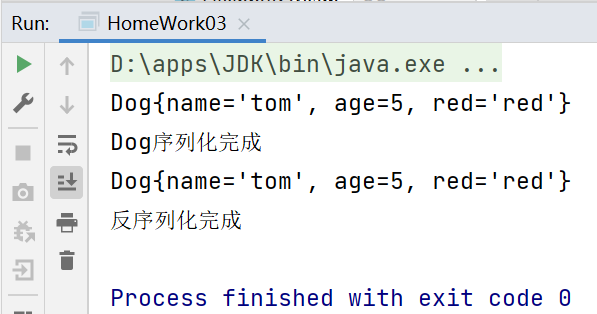JavaIO流05¶
4.常用的类04¶
4.4节点流和处理流03¶
4.4.8打印流-PrintStream和PrintWriter¶
打印流只有输出流,没有输入流
1.简单介绍及应用¶
- PrintStream是**字节打印流**
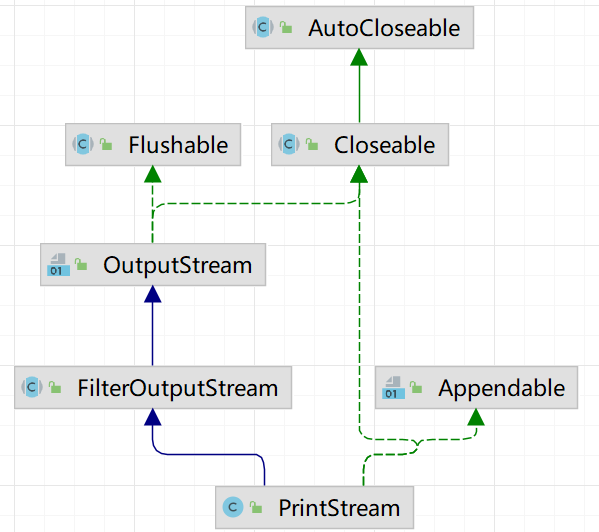

例子1:演示PrintStream(字节打印流/输出流)
package li.io.printstream;
import java.io.IOException;
import java.io.PrintStream;
/**
* 演示PrintStream(字节打印流/输出流)
*/
public class PrintStream_ {
public static void main(String[] args) throws IOException {
PrintStream out = System.out;
//在默认情况下,PrintStream 输出数据的位置是 标准输出,即显示器
out.print("jack,hello");
/**
* public void print(String s) {
* if (s == null) {
* s = "null";
* }
* write(s);
* }
*/
//因为print底层使用的是write,所以我们可以直接调用write进行打印/输出
out.write("Hello北京".getBytes());
out.close();
//我们可以去修改打印流输出的位置/设备
// 1.修改为打印到d:\f1.txt
// 2."落霞与孤鹜齐飞,秋水共长天一色" 这句话就会打印到d:\f1.txt里
// 3.System.setOut底层:
/**
* public static void setOut(PrintStream out) {
* checkIO();
* setOut0(out);//native方法 ,修改了 out
* }
*/
System.setOut(new PrintStream("d:\\f1.txt"));
System.out.println("落霞与孤鹜齐飞,秋水共长天一色");//打印到d:\f1.txt
}
}
运行结果:
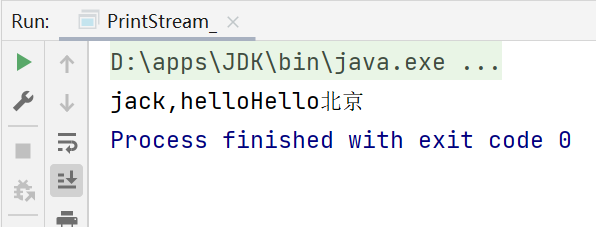
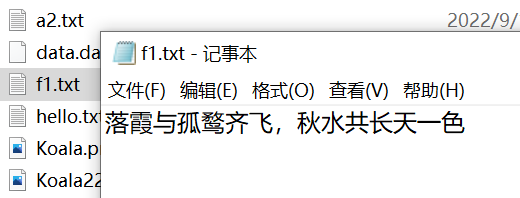
如上所示:在修改了打印流 输出的位置/设备之后,再调用System.out.println方法,打印/输出的地方就变为指定的文件路径,点击System.setOut方法,可以看到底层是调用了setOut0方法,该方法是本地方法(native)。它会去修改out,即修改输出数据的位置:


- PrintWriter是**字符打印流**
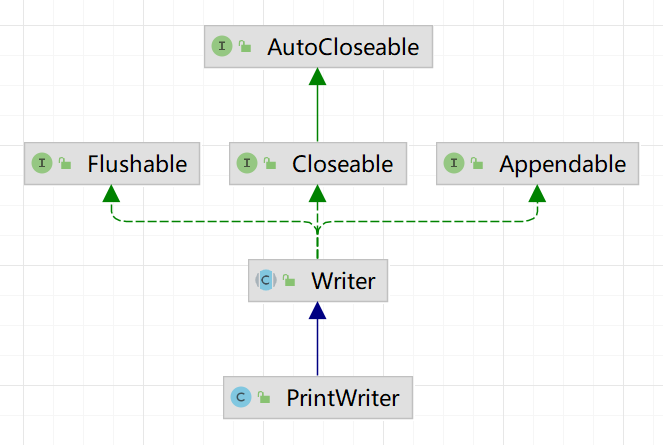
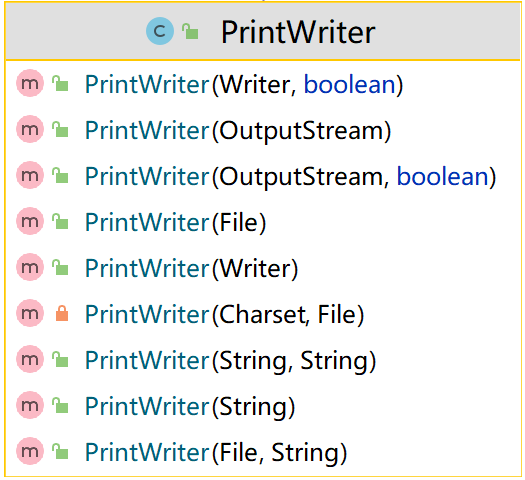
例子2:
package li.io.printstream;
import java.io.FileWriter;
import java.io.IOException;
import java.io.PrintWriter;
/**
* 演示PrintWriter的使用方式
*/
public class PrintWriter_ {
public static void main(String[] args) throws IOException {
//PrintWriter printWriter = new PrintWriter(System.out);
//向PrintWriter构造器中传入一个FileWriter对象
PrintWriter printWriter = new PrintWriter(new FileWriter("d:\\f2.txt"));
printWriter.print("hi,北京你好~");
printWriter.close();//flush()+关闭流,才会将数据写入到文件中
}
}

4.5Properties类¶
- 看一个需求:
如下一个配置文件 mysql.properties:
ip=192.168.0.13
user=root
pwd=12345
问编程读取ip、user、pwd的值是多少要怎么做?
分析:
- 传统的方法
- 使用Properties类可以方便实现
例子:传统方法
在scr文件夹下创建一个mysql.properties文件,内容为
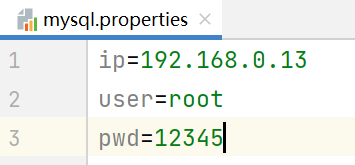
package li.io.properties_;
import java.io.BufferedReader;
import java.io.FileReader;
import java.io.IOException;
public class Properties01 {
public static void main(String[] args) throws IOException {
//读取mysql.properties文件,并得到ip,user,pwd
//创建
BufferedReader br = new BufferedReader(new FileReader("src\\mysql.properties"));
String line = "";
//读取
while ((line = br.readLine()) != null) {//循环读取
String[] split = line.split("=");
System.out.println(split[0] + "值是: " + split[1]);
}
//关闭
br.close();
}
}

如上所示,如果mysql.properties的参数很多,并且要求读取修改其中一项或者n项参数,那么使用传统的读取方法,就需要我们对读取的参数进行条件判断,一旦要读取的参数过多,代码就会变得非常繁琐。这时候就需要使用到Properties类。
4.5.1基本介绍¶

Properties是Hashtable的子类,是专门用于读写配置文件的集合类:
1)配置文件的格式:
键=值
键=值
2)注意:键值对之间不需要有空格,值不需要用引号括起来。默认的类型是String
3)Properties的常见方法:
- load:加载配置文件的键值对到Properties对象
- list:将数据显示到指定设备/流对象
- getProperty(Key):根据键获取值
- setProperty(Key,Value):设置键值对到Properties对象
- store:将Properties中的键值对存储到配置文件中,在idea中,保存信息到配置文件,如果含有中文,会存储为unicode码
应用案例1:使用Properties类完成对mysql.properties 的读取
package li.io.properties_;
import java.io.IOException;
import java.io.FileReader;
import java.util.Properties;
public class Properties02 {
public static void main(String[] args) throws IOException {
//使用Properties类来读取 mysql.properties 文件
// 1.创建Properties对象
Properties properties = new Properties();
// 2.加载指定的配置文件
properties.load(new FileReader("src\\mysql.properties"));
// 3.将 k-v 显示到控制台
properties.list(System.out);
// 4.根据key获取对应的值
String user = properties.getProperty("user");
String pwd = properties.getProperty("pwd");
System.out.println("用户名=" + user);
System.out.println("密码=" + pwd);
}
}
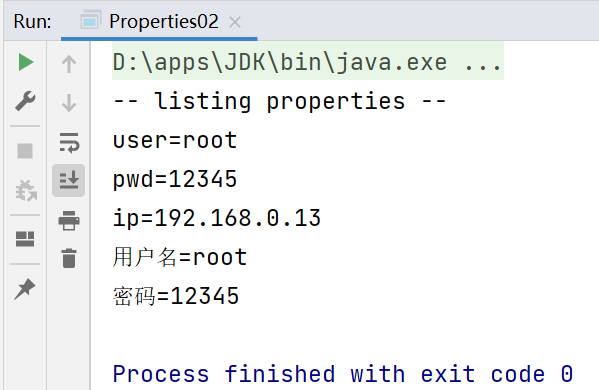
应用案例2:使用Properties类添加 key-value 到新文件 mysql2.properties 中,并修改某个 key-value
package li.io.properties_;
import java.io.FileOutputStream;
import java.io.IOException;
import java.util.Properties;
public class Properties03 {
public static void main(String[] args) throws IOException {
//使用Properties类添加 key-value 到新文件 mysql2.properties 中
//创建对象
Properties properties = new Properties();
//创建
//如果该文件没有key,就是创建
//如果该文件有key,就是修改/替换
/**
* Properties类的父类就是 Hashtable ,底层就是 Hashtable的核心方法
* public synchronized V put(K key, V value) {
* // Make sure the value is not null
* if (value == null) {
* throw new NullPointerException();
* }
*
* // Makes sure the key is not already in the hashtable.
* Entry<?,?> tab[] = table;
* int hash = key.hashCode();
* int index = (hash & 0x7FFFFFFF) % tab.length;
* @SuppressWarnings("unchecked")
* Entry<K, V> entry = (Entry<K,V>)tab[index];
* for(; entry != null ; entry = entry.next) {
* if ((entry.hash == hash) && entry.key.equals(key)) {
* V old = entry.value;//如果key存在,就替换
* entry.value = value;
* return old;
* }
* }
*
* addEntry(hash, key, value, index);//如果是新的key,就添加新 key
* return null;
* }
*/
properties.setProperty("charset", "utf-8");
properties.setProperty("user", "汤姆");//注意:保存的是中文的Unicode码值
properties.setProperty("pwd", "abcd123");
properties.setProperty("pwd", "1111");//替换
//将k-v存储到文件中即可
properties.store(new FileOutputStream("src\\mysql2.properties"), null);//第二个参数是添加注释
System.out.println("保存配置文件成功~");
}
}
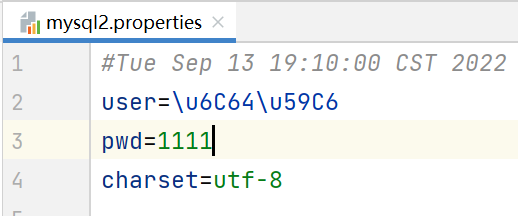
查询发现 \u6C64\u59C6 对应的中文就是 汤姆

5.IO习题¶
5.1Homework01¶
(1)判断d盘下是否有文件夹mytemp,如果没有就创建mytemp
(2)在d:\mytemp目录下,创建文件hello.txt
(3)如果hello.txt已经存在,就提示该文件已经存在,就不要重复创建了
(4)并在hello.txt文件中写入内容"hello,world".
package li.io.homework;
import java.io.File;
import java.io.FileOutputStream;
import java.io.IOException;
public class HomeWork01 {
public static void main(String[] args) throws IOException {
String filePath = "d:\\mytemp\\hello.txt";
String dictionaryPath = "d:\\mytemp";
//创建对象
File file = new File(dictionaryPath);//目录
File file2 = new File(filePath);//文件
FileOutputStream fileOutputStream = null;
if (!file.exists()) {//如果目录不存在
if (file.mkdir()) {//创建目录
System.out.println("创建目录mytemp成功~");
}
} else {
System.out.println("目录mytemp已存在");
}
if (file2.exists()) {
System.out.println("hello.txt文件已存在");
//如果文件存在,就写入数据
fileOutputStream = new FileOutputStream(filePath);
fileOutputStream.write("hello,world".getBytes());
System.out.println("已写入数据~");
} else {
if (file2.createNewFile()) {
System.out.println("创建hello.txt文件成功~");
//如果文件存在,就写入数据
fileOutputStream = new FileOutputStream(filePath);
fileOutputStream.write("hello,world".getBytes());
System.out.println("已写入数据~");
}
}
//关闭流
fileOutputStream.close();
}
}
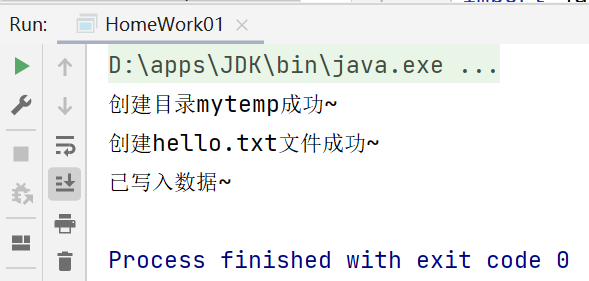

5.2Homework02¶
编程题:要求:使用BufferedReader读取一个文本文件,为每行加上行号,再连同内容一并输出到屏幕上。
package li.io.homework;
import java.io.BufferedReader;
import java.io.FileReader;
import java.io.IOException;
public class HomeWork02 {
public static void main(String[] args) throws IOException {
String filePath = "d:\\story.txt";
String line = "";
int i = 0;//行号
//创建对象
BufferedReader br = new BufferedReader(new FileReader(filePath));
//读取
while ((line = br.readLine()) != null) {
System.out.println((++i) + "\t" + line);
}
//关闭流
br.close();
}
}
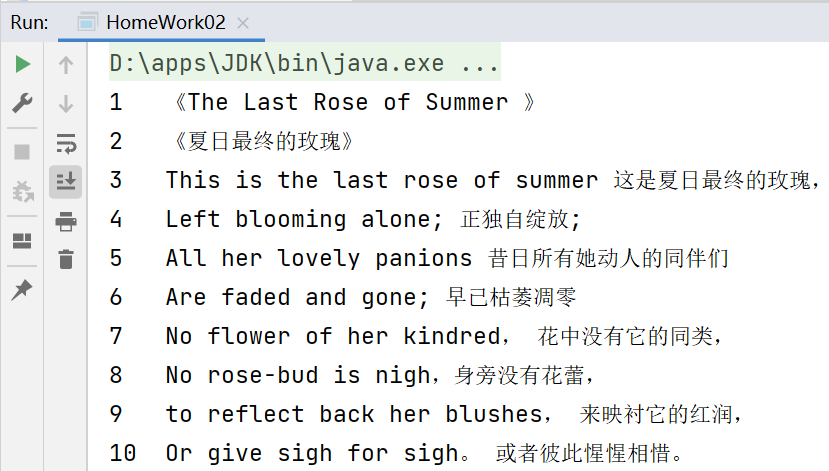
要求2:如果将文本的编码改为GBK,怎么将其输出到控制台上而不使其乱码?
使用转换流,FileInputStream→InputStreamReader(指定编码)→BufferedReader
package li.io.homework;
import java.io.*;
public class HomeWork02 {
public static void main(String[] args) throws IOException {
String filePath = "d:\\story.txt";
String line = "";
int i = 0;//行号
//创建对象
BufferedReader br = new BufferedReader(new InputStreamReader(new FileInputStream(filePath),"GBK"));//使用转换流,选择编码为“GBK”
//读取
while ((line = br.readLine()) != null) {//循环读取
System.out.println((++i) + "\t" + line);
}
//关闭流
br.close();
}
}
5.3Homework03¶
编程题:
- 要编写一个dog.properties
name=tom
age=5
color=red
-
编写Dog类(name,age,color)创建一个dog对象,读取dog.properties 用相应的内容完成初始化,并输出
-
将创建的Dog对象,序列化到 文件 dog.dat文件
-
再反序列化dog对象
package li.io.homework;
import java.io.*;
import java.util.Properties;
public class HomeWork03 {
public static void main(String[] args) throws IOException, ClassNotFoundException {
//1.编写dog.properties
//创建Properties对象
Properties properties = new Properties();
//在properties对象中添加k-v
properties.setProperty("name", "tom");
properties.setProperty("age", "5");
properties.setProperty("color", "red");
//将properties对象的k-v存储到文件中
properties.store(new FileOutputStream("src\\dog.properties"), null);
//2.读取dog.properties完成Dog对象 的初始化
int age = Integer.parseInt(properties.getProperty("age"));
Dog dog = new Dog(properties.getProperty("name"), age, properties.getProperty("color"));
System.out.println(dog);
//3.将创建的Dog对象,序列化到 dog.dat文件
String filePath = "d:\\dog.dat";
ObjectOutputStream oos = new ObjectOutputStream(new FileOutputStream(filePath));
oos.writeObject(dog);
//关闭流
oos.close();
System.out.println("Dog序列化完成");
//4.反序列化dog对象
ObjectInputStream ois = new ObjectInputStream(new FileInputStream(filePath));
Dog dog1 = (Dog) ois.readObject();
System.out.println(dog1);
//关闭流
ois.close();
System.out.println("反序列化完成");
}
}
//序列化的类要实现Serializable接口
class Dog implements Serializable {
private String name;
private int age;
private String red;
public Dog(String name, int age, String red) {
this.name = name;
this.age = age;
this.red = red;
}
@Override
public String toString() {
return "Dog{" +
"name='" + name + '\'' +
", age=" + age +
", red='" + red + '\'' +
'}';
}
}
